MANAGING A MASTERPIECE: THE STOUR VALLEY LANDSCAPE PARTNERSHIP
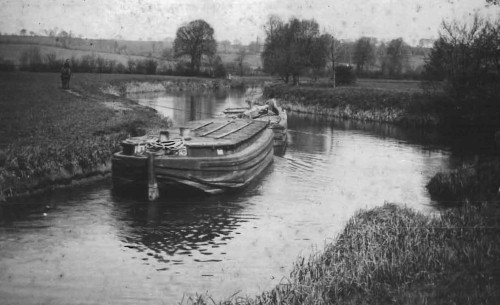
A lighter in use on the Stour.
Many of you may have seen or heard the phrase ‘Managing a Masterpiece’ Landscape Partnership Scheme in the local, and sometimes national, media, relating to a project in the Stour Valley, but how many people actually know what is it?
Firstly, what is a ‘Landscape Partnership’? According to the Heritage Lottery Fund’s website, which will fund up to 90% of such schemes, a Landscape Partnership is: A programme that helps conserve areas of distinctive landscape by delivering conservation benefits on a landscape scale, as well as helping people learn about and access our unique countryside.
The Stour Valley Landscape Partnership, known as ‘Managing a Masterpiece’, is a partnership of the Dedham Vale AONB and Stour Valley Project, local authorities, education establishments and charities that have come together to develop a series of 62 wildlife, landscape, archaeological and access projects in the Stour Valley.
Managing a Masterpiece is a £1.1m investment over 3 years into landscape projects in the Stour Valley. It is funded predominately, at around 86%, by the Heritage Lottery Fund. The remaining funds come from the Dedham Vale AONB and Stour Valley Project, seven local authorities, Natural England and English Heritage. The River Stour Trust has also contributed to improve the outcome of an individual project.
The Scheme is now into its third year of delivery. The projects completed so far have ranged from those with a high profile, such as the restoration of the Stour Lighter; archaeological digs; the Dedham Vale Hopper Bus and panoramic photographs taken from the top of church towers, to projects with less public profile but still important to improve visitor and residents appreciation and understanding of the Stour Valley. These projects include courses run at the University of Essex on landscape history and the Stour Navigation, self-guided walks, leaflets from Sudbury, Bures and Marks Tey railway stations and courses run in schools concentrating on traditional skills and traditions such as building techniques and songs and dances.
With such a wide range of projects, the Scheme’s staff made up of just three individuals, two of whom work part time, have worked extremely hard and effectively to deliver the projects on time and to budget. The Heritage Lottery Fund has consistently praised the Scheme in their quarterly monitoring visits, and regional staff and board members have visited the Scheme to help promote and celebrate various elements of it.
Some of the highlights. . .
Perhaps the most high profile, challenging and to some people controversial project was the restoration of the Stour Lighter, or barge, the John Constable. The Scheme had originally proposed funding a feasibility study into the restoration of a lighter, but the Heritage Lottery Fund encouraged the board to be bolder and bid for a full restoration. Taking soundings from boat builders, marine surveyors and boat experts at the Heritage Lottery Fund and others, the board sanctioned the bid to include a project to restore a lighter. Once the grant had been awarded, the Managing a Masterpiece staff organised a competitive tendering process. Six companies expressed an interest in restoring the vessel but in the final analysis the Pioneer Sailing Trust based in Brightlingsea won the contract. The Trust has an impressive track record in boat restorations and the experience of running the apprentice scheme associated with the project, and quoted within budget. Once the contract was awarded, the vessel was moved from its location to the Pioneer Sailing Trust’s workshop in a delicate operation.
Once at the workshop, the vessel’s dimensions were recorded and the restoration began. While nearly all of the timbers in the vessel were unusable and had to be replaced, the work is still defined as a restoration as the new timbers were placed in the position of the old ones.
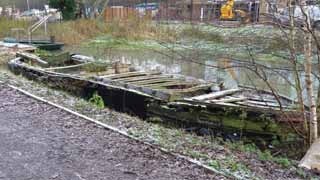
The John Constable prior to restoration.
The Lighter is owned by the River Stour Trust who had recovered it from the Ballingdon Cut, off the River Stour, where it had been scuttled during the Great War as a precaution against any possible use by invading forces. The vessel was taken out of the cut in around 1976 and restored by the River Stour Trust, and for a short period of time was used as an education vessel. However, the vessel was soon requiring further repair which was not affordable and the vessel was stored outside the River Stour Trust’s Visitor and Education Centre in Great Cornard.
The Lighter would have once been part of a pair, the rear barge acting as a giant rudder. The John Constable is an example of a front barge and they would have at one time travelled between Sudbury and Mistley. The Lighters would carry goods from the Stour Valley downstream and then these goods would be transferred to larger vessels to be taken to London and beyond. The goods leaving the Stour valley included bricks. It is thought that many of the bricks that built the Albert Hall and London Liverpool Street railway station came from this area. The return journey had the slightly less glamorous cargo of ‘night soil’ (a polite way of saying manure from horses working in London) that was used to fertilise the fields of the Stour Valley.
The original vessels were pulled up and downstream using horses. As there is no official tow path the horses often had to swap banks by means of climbing on the vessel and being taken across to the other side with the crew propelling the vessel with long wooden poles know as quant poles. The scene of horses being transferred from one bank to the other was depicted by the painter John Constable in his works entitled: The White Horse and The Leaping Horse. The restored vessel will be propelled by silent electronic motors and, due to the requirements of modern day safety requirements, quant poles will also be kept on the vessel as a secondary source of propulsion.
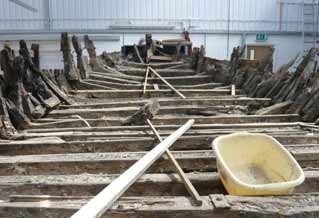
The John Constable at the Pioneer sailing Trust workshop before restoration.
One of the unusual features of the vessel was the clinker built nature of construction, meaning the restoration needed to shape and bend some large pieces of timber. The vessel has a very flat bottom which is kept attached to the sides using single pieces of timber that have an almost 90 degree bend in them. The need to source enough of these pieces at the right size and quality led to a national search, with Pioneer Sailing Trust staff travelling the length of England on the strength of promises and rumours.
Once the vessel was restored it was taken back to Cornard, via a brief stop-over in Ipswich for a press call that attracted local media, radio and television interest. It was launched back into the water and is undergoing trials before an official public launching ceremony in Spring 2013, before it earns its keep as a passenger-carrying vessel running between Sudbury and Great Henny.
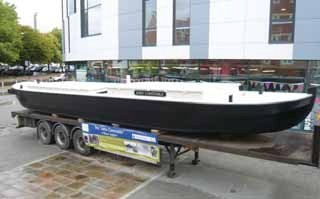
The restored Stour Lighter on display in Ipswich.
The Dedham Vale Hopper bus, first started as a pilot in 2005, was revived thanks to funding from Managing a Masterpiece. Over the three years of operation the bus has transported thousands of people on a circular route starting and ending at Manningtree, but including East Bergholt, Stratford St Mary and Dedham.

Dedham Vale Hopper Bus.
The plan had been to move visitors around the area without them having to use their own cars. What hadn’t been anticipated to such a degree was the popularity of the service to residents. From surveys undertaken on board the bus it was found that nearly 50% of the users were local residents getting to nearby villages to meet with friends or access local shops and services. One project that has really caught local residents’ imagination was the archaeological digs. Early on in the Scheme’s lifetime was the dig at Wormingford Hill that excavated a Tudor Hunting-Lodge overlooking Smallbridge Hall. It turned out that the site also had a well and what looked like a brewery. Hundreds of volunteer man hours went into the excavation and many more local school children visited the dig. The work was recorded and a ‘coffee table’ publication of the findings is available from the Colchester Archaeological Group. The well was excavated to a depth of nearly 15 metres. Right at the bottom the volunteers found the workings of an old pump system. The pump was carved from wood and is similar in design to that of a modern day bicycle pump. A length of elm, around 2 metres long, had been hollowed out which the piston would have been driven up and down to create the vacuum required to pull the water. Also of particular interest were parts of decorated brick, wall tiles and a number of coins found on site, indicating a high status building on a much earlier site. The coins found included a silver sixpence of Elizabeth, dating from 1561 to 1566 and a ‘Coin of Cunobelin’, who ruled south eastern England from his capital of Colchester in the First century AD.
There were other equally successful digs in Clare, Nayland, Stoke by Nayland, Bures Common and Mount Bures. Each dig gave the local community a chance to learn more about the history of their village and take part in an archaeological dig under the watchful eye of experts from Access Cambridge archaeology or County Archaeological Services. The Nayland test pitting programme, where villagers were encouraged to dig a one metre square in their garden and record what they found, turned up a large amount of pottery as might be expected from this historical settlement. Finds included wares from Roman times and early medieval sand ware (dating from 1100-1400). There were also many finds of locally produced material including Hedingham ware, Thetford ware and Harlow slipware, as well as finds from wares further afield such as examples of Staffordshire Manganese ware and German Stone ware. Also found was an Elizabethan coin dating from 1567. Over 150 people from the village were involved in examining thirty-four test pits in the village, and the weekends activities culminated in a presentation from the archaeologists and an evening barbeque.

School children taking part in Wormingford dig.
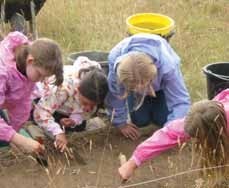
Archaeological dig on Bures Common.
Another project that caught the imagination was the taking of panoramic photographs from the top of church towers. These amazing photographs have been loaded onto a ‘pod’, essentially a computer on a pedestal, which is touring the churches of the Stour Valley. Prints of the images were made available to each church but they come alive when seen electronically on the pod or online on the Managing a Masterpiece website. When viewed electronically, one can zoom in on features of interest and jump to the next viewpoint.
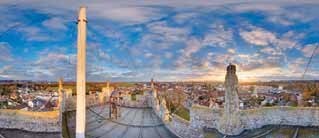
Panoramic photograph taken from the top of All Saints Church, Sudbury.
Landscape and wildlife are also important elements in Managing a Masterpiece. Over sixty riverside trees have been pollarded; many of the iconic trees between Flatford and Dedham have been pruned, ensuring these important trees live longer. Once, the trees would have been regularly pollarded for firewood or bean poles, but since markets for this type of product have been filled by cheaper suppliers, the trees have become in danger of becoming over mature and literally pulling themselves apart, as boughs become too heavy and splinter off causing deep fissures in the main trunk.
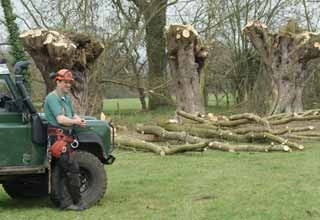
Pollarding near Flatford
Over 1.5km of hedging has been planted in the Stour Valley, restoring three lengths of hedgerow that had been removed. Along with the thousands of trees put in for the hedgerows, another sixty riverside trees have been planted alongside the Stour and its tributaries in specially constructed exclosures to prevent grazing by stock. Suitable native trees have been selected, such as willow, ash and native black poplar, Britain’s rarest timber tree. As the scheme develops in its third and final year, the emphasis has been more on celebrating the Stour Valley landscape. A series of projects are currently being organised to encourage and inspire children and disadvantaged groups to study the landscape, and to take part in photographic and art based competitions. Hundreds of high quality photographs were submitted for the competition that ran over a whole year with the three themes of heritage, farming and landscape. The judges eventually picked winning entries from the adult and under 16 age categories, with many of the winning entries being selected for a 2013 calendar. The profits were donated to the Stour Valley Environment Fund, to support environmental projects in the area.
Other arts based projects include open air lessons and school mosaic projects. 2013 will see projections onto church towers, poetry commissioned and competitions for budding poets from the local community. A lasting legacy?
Managing a Masterpiece has affected lives of many from the Stour Valley and beyond. It has directly employed three people during its lifetime and its contracts to run various elements of the scheme have supported local businesses.
When the scheme was being planned it was always an aim to have community-run events overseen by professionals. I think this has been achieved by the numbers that have been touched by Managing a Masterpiece. There are tangible achievements too: the Stour Lighter, archaeological finds, pieces of artwork, restored archaeological assets, walking and riding leaflets, new hedgerows, panoramic photographs. It is perhaps the intangible benefits we should dwell on. After two and a half years the project has had over 3,500 volunteer days on archaeological, countryside, art and learning events. Each one of those volunteers has learnt something about the Stour Valley and contributed to the shared knowledge of it. It is those people who have learnt new skills: the Stour lighter apprentice who got his first job; the wheelchair-using owner of Mount Bures Castle being carried to the top of the Motte; the hordes of schoolchildren working on archaeological digs and even rumours of a couple who met and became partners at a Managing a Masterpiece event.
To be continued. . .
Managing a Masterpiece has been such a success due to its partners delivering on time and to budget. The 10% contingency that the Heritage Lottery Fund insists being included in the initial budget has hardly been touched, and following a representation from the team, the Scheme is to be extended by a further six months. The new work is a mixture of repeats of successful projects and new ideas. They are: an archaeological excavation; archaeological fieldwalking; heritage workshop; traditions, folklore and custom course for schools; basket making course; use of the Stour Lighter as a floating classroom and the appointment of an apprentice to work on the restoration of medieval burial hatchments. We hope that you have managed to learn more about the Stour Valley from one of the Managing a Masterpiece projects. If not there is much information about the Scheme’s findings on its website at www.managingamasterpiece.org
Simon Amstutz
Simon Amstutz in AONB manager at the Dedham Vale AONB and Stour Valley Project and developed the Managing a Masterpiece scheme alongside others with a professional and personal interest in the Stour Valley.
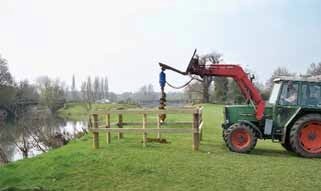
Construction of riverside tree guard.
